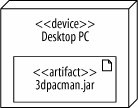Section 15.1. Deploying a Simple System
15.1. Deploying a Simple SystemLet's start by showing a deployment diagram of a very simple system. In this simplest of cases, your software will be delivered as a single executable file that will reside on one computer. To show computer hardware, you use a node, as shown in Figure 15-2. Figure 15-2. Use nodes to represent hardware in your system This system contains a single piece of hardwarea Desktop PC. It's labeled with the stereotype <<device>> to specify that this is a hardware node.
Now, you need to model the software that runs on the hardware. Figure 15-3 shows a simple software artifact (see "Deployed Software: Artifacts," next), which in this case is just a JAR file named 3dpacman.jar, containing a 3D-Pacman application. Figure 15-3. A physical software file such as a jar file is modeled with an artifactFinally, you need to put these two pieces together to complete the deployment diagram of your system. Draw the artifact inside the node to show that a software artifact is deployed to a hardware node. Figure 15-4 shows that 3dpacman.jar runs on a Desktop PC. Figure 15-4. Drawing an artifact inside a node shows that the artifact is deployed to the node But is it really complete? Don't you need to model the Java Virtual Machine (JVM) because without it, your code wouldn't execute? What about the operating system; isn't that important? The answer, unfortunately, is possibly. Your deployment diagrams should contain details about your system that are important to your audience. If it is important to show the hardware, firmware, operating system, runtime environments, or even device drivers of your system, then you should include these in your deployment diagram. As the rest of this chapter will show, deployment diagram notation can be used to model all of these types of things. If there's a feature of your system that's not important, then it's not worth adding it to your diagram since it could easily clutter up or distract from those features of your design that are important. |
EAN: 2147483647
Pages: 175